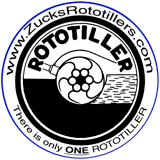This article was originally published in the February ~ March 2013 issue of the Vintage Garden Tractor of America newsletter. Mr. Jim Cunzenheim has allowed me to include it on my site. This particular version has been edited to correct some errors and add some new information.
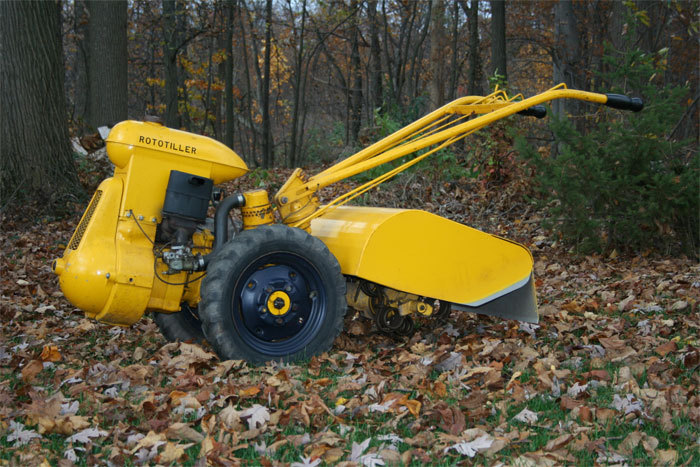
The Brief History Of The Frazer Rototiller
You may think it strange that an automobile manufacturing company would build a Rototiller. Graham-Paige Motors built the Graham-Bradley tractor from 1937 to 1940 and sold it through Sears & Roebuck. Production of the tractor stopped when the war broke out and G-P switched to military production building an amphibious tractor nicknamed the “Alligator”, aircraft engine components, PT boat engines, and naval torpedoes. By the end of 1941 G-P was in the black after 13 years of red ink. Joe Graham said he intended to stay in the black and inferred he would stay out of the auto business. He retired as president in early 1942, but stayed on the board. The new president, Mr. Hodgson had to decide on what the company would do as the war was ending.
Meanwhile, C W Kelsey, founder of Rototiller, Inc. in Troy, NY wanted to get out of the large commercial type tillers and concentrate on tillers for the homeowner. Before founding Rototiller, Kelsey was in the automobile business and no doubt still had connections. It appears that Rototiller and G-P connected and G-P decided to get into the tiller business. On a trip to Rensselaer County Historical Society in June 2012 to research the history of Rototiller, Inc., I found a copy of a letter from Rototiller’s lawyer to Mr. W L Eaton, Vice President of Graham-Paige Motor Company dated June 28, 1944, stating that an agreement has been prepared along the lines discussed with him and Mr. Kelsey. So it seems that the agreement for G-P to make the large commercial tiller was under way before Joe Frazer joined G-P in August of 1944. For whatever reason, Hodgson and Eaton left G-P shortly after this. One source said that these two men had an agreement to leave at the end of the war, but that was almost a year away. Mr. Eaton became a Rototiller distributor on the West coast and a later a Director of Rototiller, Inc. Shortly after Mr. Frazer came on board he made it clear that G-P would be back in the automobile business.
As part of the agreement, Rototiller supplied two prototypes and three extra engines according to transcripts of interviews with employees of that time period. The photo below is my B1-3, the last commercial size model Rototiller made in Troy, NY. The B&W photo is one of two prototypes that were built by Phil Carabis with the help of Kelsey and chief engineer George Done, who would later build the Troy-Bilt Horse.
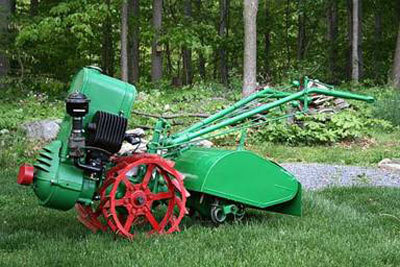
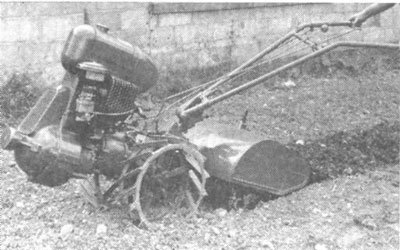
Apparently G-P made another prototype, since the B1-6 does not look like the tiller that was made in Troy by Phil Carabis. The tiller in the photo below is definitely a prototype that is almost identical to the B1-6. Could this be a B1-5?
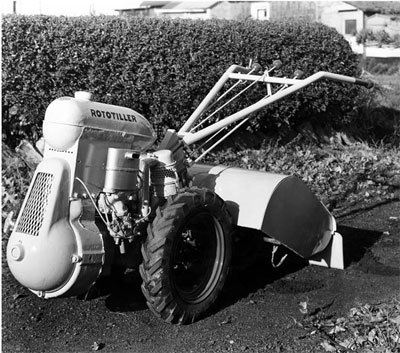 In
April 1946 the first shipment of B1-6 tillers was made from Willow Run,
MI. These tillers were built by G-P’s Farm Equipment
Division. This division was established for manufacturing
agricultural machinery as a separate operation when G-P and
Kaiser-Frazer joined in July 1945. It seems like a lot of time
passed from when the agreement was first talked about until a machine
was
available to the public. The US was in war mode and practically
all manufacturing was committed to war materials. G-P was given
the order to stop war production on September 2, 1945, now they could
proceed with peace time production.
In
April 1946 the first shipment of B1-6 tillers was made from Willow Run,
MI. These tillers were built by G-P’s Farm Equipment
Division. This division was established for manufacturing
agricultural machinery as a separate operation when G-P and
Kaiser-Frazer joined in July 1945. It seems like a lot of time
passed from when the agreement was first talked about until a machine
was
available to the public. The US was in war mode and practically
all manufacturing was committed to war materials. G-P was given
the order to stop war production on September 2, 1945, now they could
proceed with peace time production.
At first these tillers were sold through the same dealerships that sold Kaiser-Frazer cars. G-P said they were making only bare profit on the Rototiller and well below break even mark on the Frazer cars. “We ultimately had thousands of those Rototillers on hand” says Hickman Price, (executive assistant to the president of G-P) “a secondary product that after an initial demand failed to sell”. During 1946 G-P had lost almost $7 million dollars and by the end of 1946 plans were made for Kaiser-Frazer to get all the auto business. The farm implement business was kept by G-P and set up as a wholly owned subsidiary called Frazer Farm Equipment. By June facilities were leased in York, PA. Here is where the four-wheeled tractor known as the Jaques-Frazer Model T was assembled. The tractor used the Jaques “Mighty Mite” running gear and added the Rototiller engine. Apparently G-P had contracted Jaques Power Saw Co. of Dennison, Texas to build 10,000 units, but after 470 machines were built, G-P said they did not need any more. Jaques filed a suit against Frazer for $747,098.96, which was the amount they would have received for the 10,000 units. In early 1949 the York plant was shut down with a large inventory of unsold tillers. They even tried a direct from the factory campaign and reduced the price of them to $469.50. Finally in August of 1949 half of the farm division was sold to Mast-Foos Manufacturing Co. who produced power lawn mowers. The following year the remainder of the farm division of G-P was sold to Mast-Foos. Dallas Winslow was the owner and president of Mast-Foos, Ideal Power Lawn Mower Co., Springfield, Mass., and the Auburn-Cord-Duesenburg Co., in Auburn, IN, and eventually moved Frazer Farm Equipment to Auburn.
According to lawyer time sheets, G-P was not paying the required
royalties to Rototiller and Kelsey and his lawyers were talking about
taking action against them as early as February 6, 1945, which was
before the tillers were on the market for the public. There was a
lot of back and forth between G-P and Rototiller over this and the
agreement was finally dissolved according to a signed document on
February 5, 1951. This was after production stopped and Frazer
Farm Equipment had been sold to Mast-Foos. G-P paid Rototiller
$11,500 for the termination and now the Troy, NY, tiller manufacturer
could
use the Rototiller name once again and produced tillers under that name
until 1961, when Rototiller decided to re-finance by offering stock and
Porter-Cable purchased controlling interest.
It seems that SIMAR was still involved, somehow in this situation. Prior to Rototiller, Inc. building their own tillers, they imported tillers from SIMAR. Most likely Rototiller had an agreement with SIMAR concerning the 2-stroke engine and some other patents Rototiller was using when they were building the A and B Rototillers. I guess the use of these patent rights were passed along to G-P through the agreement between Rototiller, Inc. and G-P. I found a copy of a letter from Rototiller’s lawyers to Mr. R. Mozer, owner of SIMAR at the time, dated October 5, 1949 telling Mr. Mozer that G-P and their Farm Division “have had a tremendously unfortunate experience in the Rototiller business”. The letter goes on to say that Rototiller in Troy, NY, offered to assist in helping G-P by taking over the manufacture and sale of Rototillers as an agent of G-P, but that there was no response from G-P management.
G-P Motors eventually became what is now the Madison Square Garden Corporation of New York City. Dallas Winslow died in 1963 and Herbert Stanley Liddell Sr., his General Manager, got Frazer Farm Equipment, Huppmobile and Graham spare parts. They had enough spare parts that in 1981 you could have a new 26” B1-7 tiller built for $3599.00.
In 1977, when I got my first B1-6, Mr. Liddell was running Frazer Farm Equipment. I bought all my parts, had them bore and fit my cylinder with an oversize piston, and even bought the paint there for my tiller restoration. Mr. Liddell died in 1985 and several people were involved in trying to run the 3 businesses. In July of this year Mr. Michael Blaugher became the new owner of the Rototiller parts inventory and changed the name to Frazer Rototiller Parts, LLC. He has a very complete website with almost every part you would need to keep one of these tillers running, http://www.frazerrototillerparts.com. These tillers have an excellent reputation of making a very fine seed bed. Mine has served me well in the 12 plus years I used it in my home garden. For the short time they were produced, there are plenty still around. Of course when you look at how hefty they were built, is it any wonder?
This is the story as we know it now. I am sure as time goes on, more history will be uncovered. We believe that there is still a B1-4 out there, somewhere. I would like to know how SIMAR fits into the picture other than patent rights and supplying tillers in the pre-war years. I found some information indicating there was a law suit involving them and Rototiller, Inc. and that they were somehow connected with Graham-Paige/Frazer possibly other than just patent rights. There are still parts to the puzzle that are missing.
Reference materials for this article are listed below. Thanks
to the Rensselaer County Historical Society for allowing me to scan
materials found in my time there.
The Rototiller in America by Donald A. Jones
The Last Onslaught On Detroit by Richard M. Langworth
The Graham Brothers and Their Car by Jeffery I. Godshall
Thanks to Allen Cluett, who worked for Troy-Bilt and whose father
worked for Rototiller, Inc., and remembers as a child much history of
the early Rototiller, Inc. He has been invaluable in making
the connections I have made in my search for the history of Rototiller.
Some things I have learned since the article:
